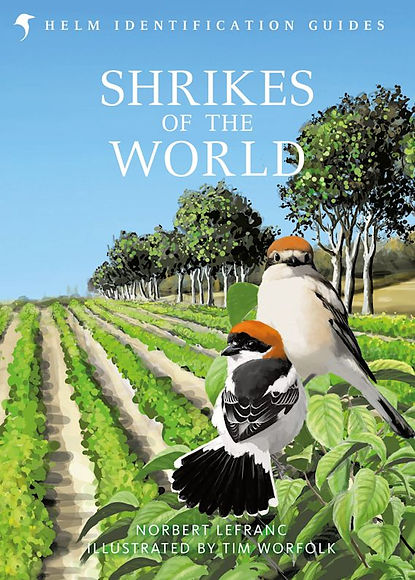top of page

Shrikes of the World (2nd edition 2022) by Norbert Lefranc. Illustrated by Tim Worfolk. Helm Identification Guides, Bloomsbury, London. Hardcover: 336 pages.
Review by Frank Lambert
(photos Nigel Voaden)
The latest Helm Identification Guide is the long-anticipated monograph on Shrikes by Norbert Lefranc, first published in 1997. This stunning new edition has been completely updated: it is a meticulously researched book, illustrated with outstanding paintings and numerous high-quality photographs of the 34 species that are covered.

Compared to the first edition Shrikes: A Guide to Shrikes of the World, this edition is radically different. Rather than use the plates from the first edition, Tim Worfolk has provided a whole new set of plates, and illustrated various taxa and plumages that were not painted for the first edition. In addition, the species accounts have been greatly expanded to incorporate not only considerable amount of new information, but also new sections on foraging behaviour, breeding success, population trends, conservation, and taxonomic notes as well as vagrancy. Consequently, for anyone interested in shrikes, this is clearly a book worth having.
Red-backed Shrike is one of the most familiar species of Lanius in Europe and parts of Africa, where it spends the winter. Although not yet considered threatened, its population has declined significantly in the last two decades.

There have been major advances in avian systematics in the 25 years since the first edition of Shrikes was published, and our understanding of the phylogenetic relationships and taxonomy of shrikes has improved vastly. To acknowledge this, and to summarise the findings, a short chapter on True Shrike Systematics by Jérôme Fuchs is included in the Introduction to the book (primarily based on Fuchs et al. 2019). The order of shrikes followed in this edition, very different from that in the first edition, follows the taxonomy summarized by Fuchs.
Although once believed to be most closely related to the bush-shrikes and allies (Malaconotidae), the Corvidae have now been shown to be the closest extant relatives of ‘true’ shrikes. In sharp contrast to the Malaconotidae, all ‘True Shrikes’ (family Laniidae), are placed in a single genus, Lanius. This includes Yellow-billed and Magpie Shrikes, which were placed in the genus Corvinella in the first edition

Genetic studies have shown that Magpie Shrike, formerly in the genus Corvinella, belongs in the genus Lanius.
The Laniidae is a relatively small family, with 32 species of Lanius recognised at the time of publication. Shrikes of the World includes these, along with two species of Eurocephalus which, although no longer treated as part of the Laniidae in this book, were included in the first edition of Shrikes (but are still treated as ‘True Shrikes’ in some taxonomies). The book does not include the Helmetshrikes or Bushshrikes (bushshrikes, tchagras, puffbacks, and boubous – some of which closely resemble ‘true’ shrikes), which are in separate families (Prionopidae and Malaconotidae, respectively).
This White-rumped Shrike, in the genus Eurocephalus, is one of the two species in this genus that are included in the second edition of Shikes. It is not, however, a 'True Shrike'. Fuchs et al. (2019) showed that Eurocephalus may be most closely related to Crested Jay Platylophus galericulatus.

Long-tailed Shrike of subspecies stresmanni from New Guinea is one of nine subspecies and a potential future split.
A perusal of the plates clearly emphasises how diverse some of the present polytypic species are, and, as pointed out by Norbert Lefranc, new molecular approaches mean that further species splits are very likely. It seems probable that some taxa in the Long-tailed Shrike L. schach complex (9 subspecies), Brown Shrike L. cristatus complex (four subspecies), and within the complex of 11 subspecies presently recognised as Great Grey Shrike L. excubitor, will appear as separate species if a third edition of this book is ever written.

Newly recognised species since the first edition include Turkestan Shrike L. phoenicuroides (treated as a subspecies of Isabelline Shrike L. isabellinus in the first edition), and the impressive Giant Grey Shrike L. giganteus, which breeds at 3,000-5,000m in northern China to Tibet, now split from Chinese Grey Shrike. Common Fiscal has been split into Southern Fiscal L. collaris and Northern Fiscal L. humeralis. In contrast, Uhehe Fiscal, a full species in the first edition, is now considered a subspecies of Southern Fiscal.
In the first edition of Shrikes, Southern Grey Shrike L. meridionalis was considered to consist of eleven subspecies. In this second edition, however, L. meridionalis is now Iberian Grey Shrike, and all the other taxa once considered to be part of Southern Grey Shrike are now part of Great Grey Shrike, including ‘Steppe Grey Shrike’ L. e. pallidirostris.


As mentioned above, the species accounts have been completely updated, and expanded to include new sections, Furthermore, there are now 21 plates illustrating the shrikes, plus five pages showing the differences in wing and tail patterns of “grey shrike taxa”. This compares with only 16 plates in the first edition, and it should also be noted that for some taxa there are many more illustrations in the second edition. Three plates are dedicated to the enormous subspecies and plumage variation of Great Grey Shrike, and two plates are devoted to Long-tailed Shrike.

Surprisingly, there are no photos of juvenile Southern, or of Northern Fiscal (depicted here) in Shrikes of the World
As with all Helm Identification Guides, the paintings are augmented with numerous photos that depict different subspecies and plumages, and occasionally capture a particular behaviour. There are also a few photos of presumed hybrids, such as between Woodchat and Red-backed Shrikes. The illustrations are of a high standard, although to my eyes, many of the pinkish or orangey tones have been reproduced poorly, so that they appear a little brighter and gaudier than in real life.
The maps are all newly drawn and take account of the huge volume of published data available since the 1990s. Lines are used to delimit the range of subspecies where possible, and some subspecies have their own maps. For example, nominate Great Grey Shrike, which overlaps in range with other subspecies in wintering areas, and ‘Desert Grey Shrike’ have their own maps, as do three subspecies of Brown Shrike.

Like every book this complex, some oversights have inevitably crept in. For example, the species account for Giant Grey Shrike says that there are few data on Voice, which is therefore not properly described, but there is a good quality recording on xeno-canto by Sander Pieterse (XC302339)

In summary, this is a very impressive monograph, and will undoubtedly remain the definitive work on the ‘True Shrikes’ for years to come. It is not simply a somewhat updated version of the first edition, but rather a completely new book, and birders and professional ornithologists will much appreciate the enormous efforts made in researching and illustrating this outstanding piece of work.
Reference
Fuchs, J. Alström, P, Yosef, R and Olsson, U. 2019. Miocene diversification of an open-habitat predatorial passerine radiation, the shrikes (Aves: Passeriformes: Laniidae). Zool. Scipta 48:571-588.
[for more photos by Nigel Voaden click here]

bottom of page
